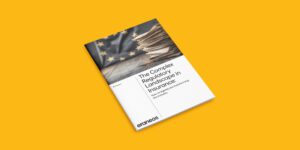Across the European Union, organizations are facing an increasingly complex regulatory landscape. From GDPR and the AI Act, to DORA for operational resilience, and ESG reporting mandates like CSRD, businesses must continuously adapt to new compliance demands while maintaining operational efficiency and controlling costs – a challenge that often feels contradictory.
In the increasingly complex world of regulations and compliance, how can AI help?
AI can transform compliance workflows by enhancing accuracy, reducing manual effort, and ensuring organizations stay ahead of evolving regulations. AI-powered solutions help businesses streamline regulatory assessments, integrate compliance into digital processes, and proactively identify risks before they’re allowed to escalate. But how do they do that?
Meet compliance challenges head-on with AI
Regulations are necessary to preserve citizen rights, safeguard privacy, and deter criminality. Few would deny their importance for protecting consumers, employees, or the environment. However, it’s also clear that adhering to regulations can create challenges.
In terms of cost, for example, the regulatory burden can be significant. One estimate placed the overall EU regulatory cost to businesses at approximately €1 trillion over a ten-year period. Depending on their jurisdiction, organizations may be subjected to a torrent of compliance requirements from their industry, region, national government, and of course, supranational regulators such as the EU. It all adds up to a maze of differing and overlapping rules that could leave even the most diligent compliance officer feeling overwhelmed.
To make matters worse, the regulatory environment rarely stands still, reacting and evolving to meet market and technology shifts. As a case in point, regulatory requirements across the European Union – from NIS2 and CSRD to DORA and CRA – are becoming more complex, forcing companies to strike a delicate balance between compliance, operational efficiency, and cost control.
Some of the challenges organizations are facing include:
- A shifting surface: Regulations are continuously evolving, increasing complexity and manual workload for businesses. Since 2015, for example, the EU has issued six anti-money laundering directives, with some reports indicating that a seventh one is currently underway. Across various sectors, from finance to healthcare, new legislation is constantly being pushed to alter the regulatory landscape. AI itself represents another good example. For some, the risk that AI potentially poses in terms of misinformation, privacy or even overthrowing the human race entirely, means the technology is in desperate need of more stringent regulation. For others, further regulation of AI threatens to stifle innovation and place businesses at a competitive disadvantage as the technology develops.
- The manual burden: Compliance processes are often fragmented, time-consuming, and prone to human error. According to research compiled by security platform Drata, IT and security professionals spend an average of 4,300 hours a year achieving or maintaining compliance. Keeping up with regulatory demands can be a significant drain on company resources. Financial costs of compliance include the salaries of compliance personnel, and the various systems included in the process. These systems will also need to be updated as regulations change, meaning new training is likely to be needed for staff. It represents a never-ending demand for resources, which could instead be put towards adding value for the company and its customers.
- A difficult balancing act: Staying ahead of new mandates while remaining agile and cost-efficient is a growing contradiction. Most organizations recognize why it’s important to meet compliance demands but are left in a difficult position. How much time, effort, and money should be directed towards compliance in the face of the many other demands placed on their business? An inability to achieve compliance could result in financial and reputational damage that ultimately results in business failure. However, investing too many resources in this area at the expense of other parts of the business, whether that’s marketing, sales, or R&D, also risks obsolescence. Businesses need to direct some of their energy towards compliance – but not at the expense of everything else.
How AI supports compliance
AI-driven solutions help organizations streamline compliance workflows, enhance accuracy, reduce manual effort, and ensure regulatory alignment, all while cutting costs and improving operational efficiency.
For compliance personnel, AI can greatly enhance efficiency, predict potential risks, and automate routine tasks like data analysis. Of course, the use of AI for compliance isn’t without its risks. Problems around bias, privacy breaches, and a lack of transparency can all be exacerbated by AI and the adoption of the technology shouldn’t be used as a justification for mass job cuts. Human compliance officers will continue to be essential.
Even so, AI could prove to be a valuable tool in supporting human compliance teams. Used correctly, AI promises to make compliance processes faster, more affordable, and more accurate.
The benefits of using AI for compliance:
- Regulatory assessments: Large Language Models can identify risks and compliance gaps automatically. At the same time. rigorous validation and evaluation processes can minimize the risk of erroneous LLM-generated outputs.
- Automated ESG reporting: The pressing threat posed by climate change means that sustainability is an area facing rapid regulatory shifts. In order to keep pace, automated ESG reporting allows businesses to collect, analyze, and format sustainability data more easily.
- Monitoring regulatory changes: Organizations have little hope of meeting evolving compliance demands unless they know exactly what the latest regulatory change involves. AI tools can help businesses remain ahead of new policies before they become costly risks by continuously scanning and monitoring regulatory databases, financial news outlets, and official announcements.
- Integration with digital processes: AI shouldn’t be viewed as a standalone tool but rather one part of a company’s evolving digital toolset. AI allows compliance checks to be seamlessly embedded into wider business operations for enhanced efficiency.
- Streamline summaries: Generative AI can create instant summaries of important information related to compliance, saving employees substantial amounts of time. For instance, detailed reports can be condensed so compliance officers gain the headline information at a glance before deciding whether they need to take a more thorough look.
- Identify trends: Whether an organization’s main compliance demands revolve around cybersecurity, fraud, or anything else, AI can be used to speed up trend and pattern analysis to identify potential risks before they escalate into bigger issues. Algorithms can learn and predict patterns, as well as identify outliers, to improve behavior analysis, traffic monitoring, malware detection, and more.
Curious how AI can help your organization stay ahead of regulatory change?
Discover our AI-powered solutions for smart, scalable compliance.

Regulatory Complexity, Simplified with AI
Not so long ago, there were only a handful of industries where compliance represented a major concern. Financial institutions, telecommunications firms, and healthcare providers may have always faced regulatory scrutiny, but a rising tide of digitalization means pretty much every organization faces compliance demands of one form or another. Fortunately, AI offers some relief from an ever-evolving maze of regulations.
At Eraneos, we’ve worked with clients in some of the most highly regulated industries, from Financial Services to Governments and Healthcare, and have seen first-hand just how important compliance can be. However, there’s no need to view compliance as a risk. It’s an opportunity and AI only brings this to the fore.
Leverage AI-powered compliance solutions to navigate the ever-changing regulatory landscape with confidence. Stay compliant, reduce costs, and focus on what truly matters – driving your business forward.




